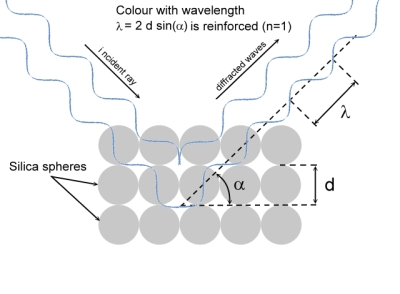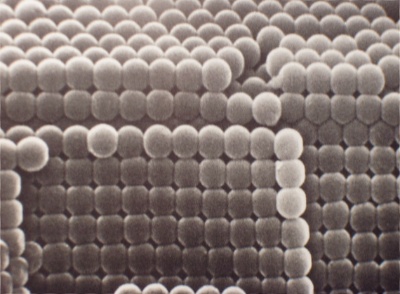Opal Play-of-colour
The play-of-colour in
precious opals may exhibit every
prismatic colour from violet to red. It is produced by the
diffraction of white light at the spaces between tiny, uniformly sized silica
spheres that are arranged in an orderly, three-dimensional array. Depending on
the diameter of the silica spheres and the angle of the incident white light one
particular wavelength (prismatic colour) is reinforced by constructive
interference while the others are diminished by destructive interference. The
structure must consist of spheres
with a uniform diameter between 200 - 350 nm to be able to produce a play-of-colour
in the visible light range from violet to red (wavelength 400 - 700 nm).
Stacking faults in the silica sphere structure of opals produce many distinct
colour patches and determine the Pattern of
an opal's play-of-colour.
This phenomenon can be described by Bragg's law which is
originally the result of experiments into the diffraction of X-rays or neutrons
off crystal surfaces at certain angles:
| 2 d sin(a) = n
l |
a = angle between the
diffracted waves and
the scattering planes |
| |
l = wavelength which is reinforced
at angle a |
| |
d = diameter of the silica spheres (distance
between the scattering planes) |
| |
n = 1, 2, 3... |
 |
 |
|
Bragg angle adapted to the silica sphere structure of
precious opal producing a play-of-colour |
Scanning electron micrograph
showing silica sphere
structure of
precious opal under 40000 x magnification |
BRAGG'S LAW explains why opals with a
red play-of-color are usually able to show all other prismatic colours too (at
least when the stone is tilted and viewed from lower angles).
COMMON OPAL and POTCH do not exhibit
a play-of-colour because the silica spheres are not uniformly sized or not
arranged in an orderly pattern or because the spaces between the spheres are
completely filled with silica. Sometimes it may also happen that the spheres
are too small (< 200 nm) to produce a visible play-of-colour. In this case the
longest wavelengths that are reinforced are part of the UV light range and
therefore not visible to the human eye. If the spheres are too large (> 350 nm)
there is no good play-of-colour with upright lighting conditions since the
reinforced waves are located in the infrared range. However if the stone is
tilted the wavelength that is reinforced becomes shorter and may move to the visible
part of the spectrum so that - at first - red colours may start to appear.
PLAY-OF-COLOUR is described by the main, dominant colour
followed by the accompanying colours. If the play-of-colour exhibits three or
more different colours the main colour followed by the term MULTICOLOUR may be
used. For example Red-multicolour stones are the rarest and most sought-after
opals.
Furthermore the appearance of the play-of-colour is classed by
Brightness and
Pattern.
|